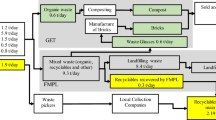Abstract
The organic fraction of municipal solid wastes in Southeast Asia, which has a high moisture content, accounts for a large proportion of total waste. Local governments need to pay adequate attention to the composition of wastes to determine alternative waste management technologies. This study proposed the use of a triangle diagram to describe changes in proximate composition and rates of successful source separation of municipal solid waste and to identify technical challenges about alternative waste management technologies such as incineration, composting, and refuse-derived fuel production based on physical and proximate composition analysis of household waste sampled in Hanoi, Vietnam, as a case study. The analysis indicated the effectiveness of different types of source separation as well as different levels of successful achievement of source separation as an adjustment mechanism for the proximate composition of waste. Proper categorization of wastes for source separation is necessary for the appropriate use of alternative waste management technologies. The results showed that, at a source separation rate of just greater than 0.52 in a three-way separation scheme, the waste separated as combustible waste would be suitable for incineration with energy recovery. Based on well-designed schemes of source separation, alternative waste management technologies can be applied.












Similar content being viewed by others
References
Memon MA (2010) Integrated solid waste management based on the 3R approach. J Mater Cycles Waste Manag 12:30–40
Cleary J (2009) Life cycle assessments of municipal solid waste management systems: a comparative analysis of selected peer-reviewed literature. Environ Int 35:1256–1266
Winkler J, Bilitewski B (2007) Comparative evaluation of life cycle assessment models for solid waste management. Waste Manag 27:1021–1031
McDogall F, White P, Franke M, Hindle P (2001) Integrated solid waste management: a life cycle inventory, 2nd edn. Blackwell Science, Oxford
Liamsanguan C, Gheewala SH (2008) The holistic impact of integrated solid waste management on greenhouse gas emissions in Phuket. J Clean Prod 16:1865–1871
Khoo HH, Lim TZ, Tan RBH (2010) Food waste conversion options in Singapore: environmental impacts based on an LCA perspective. Sci Total Environ 408:1367–1373
Bai R, Sutanto M (2002) The practice and challenges of solid waste management in Singapore. Waste Manag 22:557–567
Bangkok Metropolitan Administration (2012) Bangkok State of the environment 2010–2011. Bangkok Metropolitan Administration, Bangkok
Kathirvale S, Yunus MNM, Sopian K, Samsuddin AH (2003) Energy potential from municipal solid waste in Malaysia. Renew Energ 29:559–567
Pasang H, Moore GA, Sitorus G (2007) Neighbourhood-based waste management: a solution for solid waste problems in Jakarta, Indonesia. Waste Manag 27:1924–1938
Muttamara S, Visvanathan C, Alwis KU (1994) Solid waste recycling and reuse in Bangkok. Waste Manag Res 12:151–163
Nithikul J, Karthikeyan OP, Visvanathan C (2011) Reject management from a mechanical biological treatment plant in Bangkok, Thailand. Resour Conserv Recy 55:417–422
Damanhuri E, Wahyu IM, Ramang R, Padmi T (2009) Evaluation of municipal solid waste flow in the Bandung metropolitan area, Indonesia. J Mater Cycles Waste Manag 11:270–276
Shekdar AV (2009) Sustainable solid waste management: an integrated approach for Asian countries. Waste Manag 29:1438–1448
Thanh NP, Matsui Y, Fujiwara T (2010) Household solid waste generation and characteristic in a Mekong Delta city, Vietnam. J Environ Manag 91:2307–2321
Troschinetz AM, Mihelcic JR (2009) Sustainable recycling of municipal solid waste in developing countries. Waste Manag 29:915–923
Wilson DC, Rodic L, Scheinberg A, Velis CA, Alabaster G (2012) Comparative analysis of solid waste management in 20 cities. Waste Manag Res 30:237–254
Aye L, Widjaya ER (2006) Environmental and economic analyses of waste disposal options for traditional markets in Indonesia. Waste Manag 26:1180–1191
Chaya W, Gheewala S (2007) Life cycle assessment of MSW-to-energy schemes in Thailand. J Clean Prod 15:1463–1468
Gunamantha M, Sarto (2012) Life cycle assessment of municipal solid waste treatment to energy options: case study of Kartamantul region, Yogyakarta. Renew Energ 41:277–284
Hanoi Statistical Office (2011) Hanoi statistical yearbook 2010. Hanoi Statistical Office, Hanoi
Kawai K, Osako M (2011) Estimation of recyclable waste flows in Hanoi, Vietnam (in Japanese). Environ Sanit Eng Res 25:21–29
Ministry of Health and Welfare of Japan (1977) Protocol of waste analysis, Notification of Kansei 95th (in Japanese). Ministry of Health and Welfare of Japan, Tokyo
World Bank (1999) Municipal solid waste incineration, World Bank technical guidance report. World Bank, Washington, DC
Tanaka N, Matsuto T, Kakuta Y, Tojo Y (2003) Fundamental knowledge of waste management engineering for recycling and appropriate disposal (in Japanese). Ghihodoshuppan, Tokyo
Jakobsen ST (1995) Aerobic decomposition of organic wastes 2. Value of compost as a fertilizer. Resour Conserv Recy 13:57–71
Zhuang Y, Wu SW, Wang YL, Wu WX, Chen YX (2008) Source separation of household waste: a case study in China. Waste Manag 28:2022–2030
Japan International Cooperation Agency, Yachiyo Engineering Co., Ltd, Nippon Koei Co., Ltd (2009) Project completion report of the project for implementation support for 3R initiative in Hanoi city to contribute to the development of a sound material-cycle Society in the Socialist Republic of Vietnam. Japan International Cooperation Agency, Tokyo
Charuvichaipong C, Sajor E (2006) Promoting waste separation for recycling and local governance in Thailand. Habitat Int 30:579–594
Acknowledgments
We sincerely thank Nguyen Huu Dung of the Institute for Urban Environment and Industry of Vietnam and all the staff of the International Cooperation Department, Hanoi Urban Environment Company for supporting this study. We express our sincere and profound gratitude to the Environment Research and Technology Development Fund by the Ministry of the Environment, Government of Japan.
Author information
Authors and Affiliations
Corresponding author
Rights and permissions
About this article
Cite this article
Kawai, K., Huong, L.T.M., Yamada, M. et al. Proximate composition of household waste and applicability of waste management technologies by source separation in Hanoi, Vietnam. J Mater Cycles Waste Manag 18, 517–526 (2016). https://doi.org/10.1007/s10163-014-0348-5
Received:
Accepted:
Published:
Issue Date:
DOI: https://doi.org/10.1007/s10163-014-0348-5




